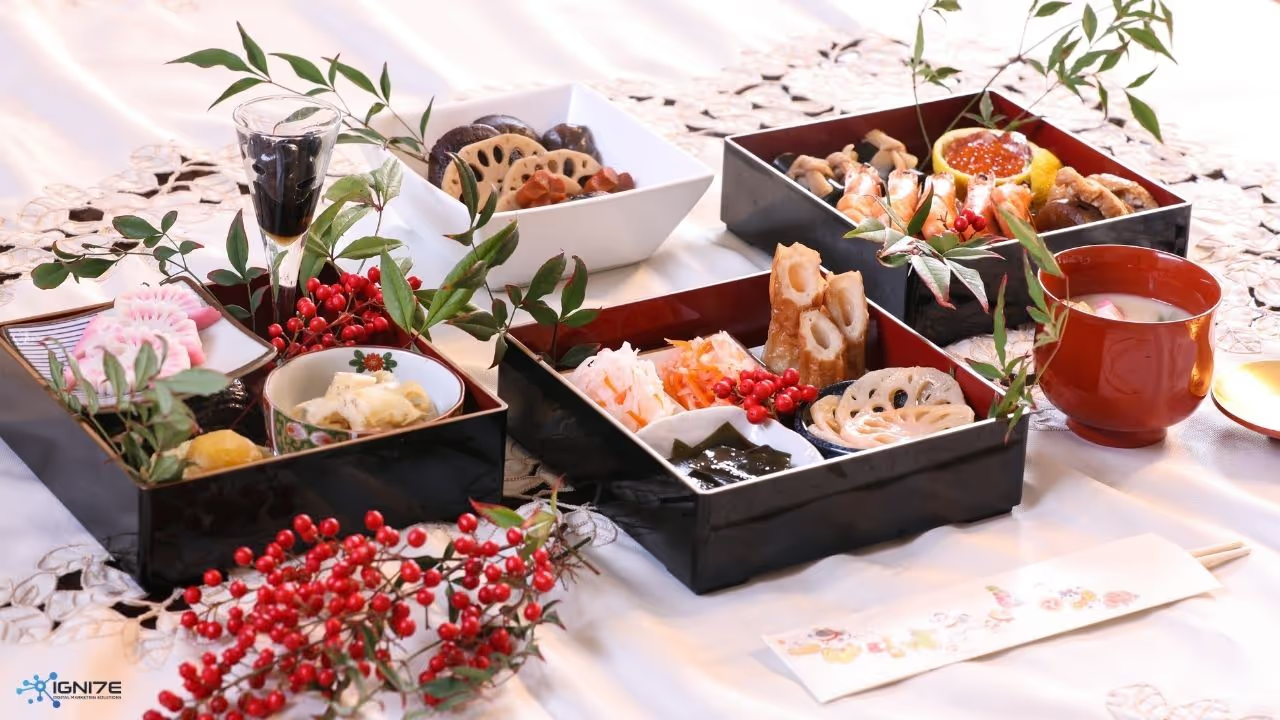Top 5 Winter Holiday Spending Habits in Japan

The end-of-year and New Year holidays in Japan are a vibrant blend of cultural traditions, family gatherings, and festive celebrations. This special time begins with the sparkle of Christmas, marked by festive lights, gift exchanges, and indulgent treats. It then transitions into New Year's Eve, a time of reflection, and New Year's Day, a moment for fresh beginnings. These holidays are steeped in meaningful customs and rituals, many of which involve thoughtful spending to create memorable experiences.
From splurging on exquisite holiday meals and exchanging heartfelt gifts to honoring traditions like buying new items for a fresh start or giving otoshidama—cash gifts symbolizing good fortune for children—the season is as much about generosity and renewal as it is about celebration. These expenditures are not merely about material items but also about fostering connections, expressing gratitude, and embracing the spirit of the holidays.
In this article, we delve into the five most common ways people in Japan allocate their holiday budgets, based on a survey conducted by Marketing Applications Inc. Each spending category reflects the unique blend of modern practices and deep-rooted traditions that define Japan's holiday season. Whether you’re exploring Japanese culture or seeking inspiration for your own celebrations, this guide offers a window into the heart of Japan's winter festivities.
Japanese Holiday Expenses
- Fancy Home Meals
- Dining Out
- Otoshidama
- Christmas Presents
- Shopping
1. Fancy Home Meals (Christmas, New Year's Eve, New Year's Dishes)

One of the most significant ways Japanese people allocate their holiday budgets is on food at home, particularly during the winter holidays. The season’s meals are not just about sustenance—they’re a way to celebrate, connect, and honor long-standing traditions. From Christmas to New Year’s, food expenses rise as families invest in special dishes that mark this festive time of year.
Christmas Delights: Cakes and Fried Chicken
Christmas in Japan has evolved into a commercial and celebratory occasion, with food playing a central role. Two iconic traditions dominate the day, both requiring planning in advance and an extra budget:
- Christmas Cake: The Japanese Christmas cake—a strawberry shortcake covered in whipped cream and festive decorations—is a must-have for the season. Originally introduced by Fujiya in 1910, this cake became a symbol of post-war prosperity and is now a staple of holiday spending. With options ranging from bakery masterpieces to single-serving cakes available at convenience stores, this dessert represents both indulgence and accessibility.
- KFC for Christmas: Thanks to a wildly successful 1974 marketing campaign, KFC has become synonymous with Christmas in Japan. Families across the country splurge on fried chicken buckets, often reserved months in advance, making it one of the most distinctive ways Japanese people spend money during the holidays.
New Year’s Eve: Toshikoshi Soba
As the year winds down, spending shifts to toshikoshi soba, a dish symbolizing resilience and letting go of the past. These buckwheat noodles, steeped in tradition, are often prepared at home or purchased from specialty shops, representing a modest yet meaningful end-of-year expense.
New Year’s Day: Osechi Ryori and Ozoni
The largest food-related expense of the season comes with New Year’s Day, Japan’s most important holiday.
- Osechi Ryori: Preparing or purchasing osechi ryori is a significant investment, as these elaborate bento-style meals include premium ingredients like herring roe, black beans, and rolled omelets. Many families choose to buy pre-made osechi from department stores or specialty shops, often spending thousands of yen on these intricately designed boxes that symbolize good fortune for the year ahead.
- Ozoni: This comforting soup, featuring toasted mochi and regional variations in ingredients, is another staple that adds to the holiday food budget.
Mochi and Sweet Treats
Throughout the holidays, mochi-based dishes such as oshiruko (sweet red bean soup) and toasted mochi with soy sauce or kinako are prepared at home or purchased from stores, further contributing to food-related spending during this period.
Food at home during the winter holidays represents one of the most heartfelt ways Japanese people spend money, blending modern indulgences with deeply rooted traditions. Whether it’s splurging on a Christmas cake, reserving a KFC feast, or investing in premium osechi ryori, these culinary expenses highlight the cultural significance of food as a way to celebrate the season.
2. Dining Out

The holiday season in Japan is synonymous with an increase in dining out, primarily driven by two unique cultural events: bounenkai (year-end parties) and shinnenkai (New Year’s gatherings). These events are more than just opportunities to enjoy food and drink; they’re meaningful social traditions that shape how Japanese people celebrate the transition from one year to the next.
Bounenkai: Forgetting the Year with Colleagues and Friends
The bounenkai, or “forget-the-year party,” is a chance to reflect on the past year, express gratitude, and let loose in the company of colleagues, friends, or club members. Held primarily in December, these gatherings are often hosted at izakayas (Japanese pubs) or restaurants offering set menus and all-you-can-drink plans. The average cost for attendees ranges from 4,000 to 5,000 yen per person, including multiple courses of food and an unlimited drink option.
Beyond the culinary indulgence, bounenkai serve as an informal space where hierarchies are momentarily set aside. Phrases like “Let’s forget about our ranks tonight” encourage open conversations between employees of all levels, fostering stronger interpersonal relationships and a sense of camaraderie within the group. This relaxed atmosphere often paves the way for discussing work-related issues more candidly, helping teams move forward with renewed understanding in the upcoming year.
Shinnenkai: Welcoming the New Year
As the New Year begins, the tradition of shinnenkai picks up where bounenkai left off. These gatherings, typically held in January, focus on celebrating the fresh start and fostering optimism for the year ahead. Similar to bounenkai, shinnenkai often involve group dining at restaurants, with costs and settings reflecting the celebratory mood. Families, friends, and workgroups alike participate, making dining out a central activity during this period.
Impact on Holiday Spending
The dining out expenses during this festive period go beyond just food. Reserving a venue for a bounenkai or shinnenkai can be a logistical challenge as restaurants fill up weeks in advance, particularly in urban areas. Younger employees, often tasked with organizing these events as the kanji (organizer), must secure reservations, manage budgets, and ensure a seamless experience for all attendees.
Additionally, some bounenkai include lighthearted entertainment, such as stand-up comedy, karaoke, or even magic tricks, which sometimes require extra spending on equipment or costumes. This blend of dining, drinking, and entertainment makes these events a significant contributor to holiday spending.
Family Dining and Seasonal Menus
While bounenkai and shinnenkai are staples of adult social life, families also partake in dining out during the holidays. Restaurants often feature special seasonal menus or limited-time dishes, enticing families to celebrate together outside the home. These meals typically carry a premium, adding another layer to holiday dining expenses.
Dining out during the holiday season is a distinct yet essential way Japanese people spend money. Whether it’s bonding with colleagues over a bounenkai, toasting to new beginnings at a shinnenkai, or sharing a festive meal with family, these gatherings underscore the importance of food and drink in fostering relationships and celebrating life’s milestones.
3. Otoshidama (Cash Gifts for Children)

One of the most eagerly anticipated New Year traditions for Japanese children is receiving otoshidama, a monetary gift from parents, grandparents, relatives, and close family friends. This custom is deeply rooted in Japanese culture and symbolizes goodwill, hope for prosperity, and blessings for the coming year. For adults, it’s a meaningful way to express gratitude to the next generation, while for children, it’s an exciting opportunity to enjoy newfound financial independence.
The Ritual and Presentation
The cash is traditionally given in decorative envelopes called pochi-bukuro, which come in a variety of designs ranging from elegant patterns to playful motifs, often featuring the zodiac animal of the year or other iconic Japanese symbols like maneki-neko or daruma. Modern versions even include popular cartoon characters, adding a touch of whimsy to the practice. The aesthetic of the pochi-bukuro reflects the festive spirit of the season and the importance of the gesture.
Historical and Cultural Roots
The origins of otoshidama are tied to ancient Shinto rituals. Historically, offerings such as kagami-mochi (round rice cakes) were presented to the toshigami, the Shinto deities of the New Year, as a symbol of gratitude and hope for protection in the coming year. After the ritual, these rice cakes were shared among family and servants. Over time, this evolved into the custom of giving small gifts, and by the Edo period (1603–1868), wealthy families had begun distributing bags of mochi or mandarins. Eventually, these tangible gifts transitioned to monetary offerings, becoming the otoshidama tradition celebrated today.
The Cost of Giving: How Much is Appropriate?
The amount given during otoshidama typically depends on the child’s age and the giver’s relationship to them. Preschoolers might receive 2,000 yen, while elementary school students might get 3,000 yen. For junior high and high school students, the amounts often rise to 5,000 yen or more. Families with multiple children or many relatives can find these expenses adding up quickly, making otoshidama one of the most significant holiday expenditures. For very young children who may not understand the value of money, toys or other gifts might replace cash.
Teaching Financial Responsibility
Receiving otoshidama is not only thrilling for children but also a valuable learning opportunity. Parents often encourage children to divide their money into savings, spending, and future purchases. While some children splurge on toys or treats, others save for larger items they’ve been dreaming about, such as video games or hobby-related gear. This balance between indulgence and prudence introduces children to basic financial management, ensuring the tradition is both festive and educational.
A Celebration of Generosity and Joy
The custom of otoshidama encapsulates the spirit of New Year’s in Japan: generosity, family bonding, and the hope for a brighter future. For children, the experience is not just about receiving money but also about participating in a cherished tradition that connects them to their cultural heritage and the support of their loved ones. For adults, it’s a meaningful way to pass on blessings and instill values of gratitude and responsibility in the next generation.
4. Christmas Presents

Gift-giving is an integral part of Japanese culture, and Christmas in Japan is no exception. Although Christmas has evolved differently in Japan, it still brings joy to children and adults alike through thoughtful exchanges of presents.
Children’s Joy: Toys, Games, and More
For children, receiving Christmas presents is one of the highlights of the holiday season. Popular gifts include toys, games, and clothing tailored to their age and interests. Parents often delight in choosing items that will bring smiles to their kids' faces, making Christmas morning a magical experience for many families.
Adults’ Celebrations: Romantic and Practical Gifts
Christmas in Japan is also seen as a romantic occasion for couples, often marked by exchanging gifts during a special dinner date. Jewelry, accessories, or small luxury items like scented candles or gourmet chocolates are popular choices. Beyond romance, adults may also participate in gift exchanges with friends and coworkers. Items like elegant stationery, artisanal tableware, or beautifully wrapped household goods are commonly exchanged.
Japanese-Inspired Gift Ideas
Japan offers a treasure trove of unique and culturally significant gift options that can elevate Christmas exchanges:
- Kokeshi Dolls: Hand-painted wooden dolls, perfect as decorative keepsakes.
- Japanese Tea Sets: Ideal for tea lovers, these sets enable recipients to enjoy a traditional tea ceremony at home.
- Wagashi Sweets: Exquisitely crafted traditional sweets, often more art than confection.
- Japanese Fans and Artwork: Whether practical or decorative, these items capture the essence of Japanese aesthetics.
- Artisanal Kitchenware: Including chopsticks, ramen bowls, and even premium Japanese knives for culinary enthusiasts.
The Art of Presentation
In Japan, the presentation of a gift is as important as the gift itself. Gifts are meticulously wrapped in beautiful paper or traditional furoshiki cloth, emphasizing thoughtfulness and care. This attention to detail adds an extra layer of appreciation to the act of giving.
Building Bonds Through Giving
Christmas presents in Japan go beyond the material; they strengthen relationships and express appreciation. Whether it’s the joy of children unwrapping toys or couples exchanging heartfelt tokens, these gifts create moments of connection and happiness during the festive season.
5. Shopping

The end of the year is a transformative period in Japan, marked by a surge in consumer activity as households prepare to welcome the new year. From cleaning and reorganizing homes to purchasing gifts and refreshing their living spaces with new appliances, furniture, and clothing, shopping becomes an integral part of the season.
The Year-End Sales Season: A Retail Highlight
Known as nenmatsu shōsen (年末商戦), the year-end sales season kicks off in late November, fueled by bonuses received in December and the festive spirit of the holidays. It encompasses major events such as Black Friday, Cyber Monday, Christmas, and New Year’s Eve, each with distinct cultural and commercial significance.
- Black Friday and Cyber Monday: These shopping days, adopted from the West, have gained momentum in Japan since 2016. Black Friday is held after Labor Thanksgiving Day on November 23, offering significant discounts at physical stores. Cyber Monday extends this shopping frenzy to online platforms, reflecting Japan's growing e-commerce trends.
- Christmas Sales: While Christmas in Japan is not a family-oriented holiday, it is celebrated with gift exchanges, especially among couples. Retailers see increased sales of jewelry, lingerie, and romantic gifts, as well as seasonal items like holiday-themed decorations and cakes.
- New Year’s Eve and Hatsuuri (First Sale): The quiet, reflective nature of New Year’s Day belies its importance to the retail sector. Stores usher in the new year with Hatsuuri sales and fukubukuro (lucky bags), bundles of discounted goods that add an element of surprise and excitement to the shopping experience.
Why Year-End Shopping Matters
- Refreshing Homes: Many Japanese households use this period to replace worn-out items, from appliances to furniture, symbolizing a fresh start for the coming year.
- Gift Giving: The tradition of buying gifts or souvenirs for visiting relatives and friends drives up expenditures. Unique Japanese gifts like omiyage (souvenirs), wagashi sweets, and artisanal tableware are popular choices.
- Retail Success: For businesses, the year-end sales season represents a significant portion of annual revenue, fostering brand visibility and cultivating customer loyalty.
Cultural Touchpoints and Local Traditions
Shopping during this period is steeped in Japanese customs. The emphasis on impeccable presentation extends to purchases, with items often wrapped beautifully in furoshiki (wrapping cloth). Promotions tied to traditional New Year’s practices, such as shrine visits and family reunions, enhance the shopping experience, blending commercial activity with cultural engagement.
A Fresh Start Through Shopping
Year-end shopping in Japan is more than just a commercial endeavor—it reflects a desire to refresh and renew, aligning with the cultural importance of starting the new year on a clean slate. Whether through purchasing practical items, engaging in festive sales, or participating in unique traditions like fukubukuro, shopping is an essential part of preparing for a prosperous year ahead.
Conclusion
The New Year holidays in Japan are a harmonious blend of cherished traditions and modern practices, reflecting the country’s deep cultural roots and evolving holiday customs. The increased spending during this period highlights not just economic activity but also the values at the heart of Japanese culture—family bonds, thoughtful gift-giving, and the importance of renewal and reflection as the year turns.
From the purchase of symbolic osechi ryori and lucky charms to the excitement of fukubukuro and year-end sales, these expenditures are more than transactions—they are investments in creating meaningful experiences and memories with loved ones. They embody the spirit of gratitude, generosity, and hope that defines the season.
By embracing these traditions while managing your holiday spending thoughtfully, you can partake in the joy of the festivities without unnecessary stress. Ultimately, the New Year holidays in Japan are a time to reconnect, refresh, and celebrate, ensuring a fulfilling and unforgettable start to the year with those who matter most.






















